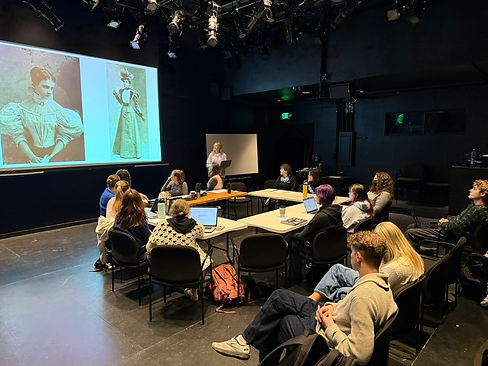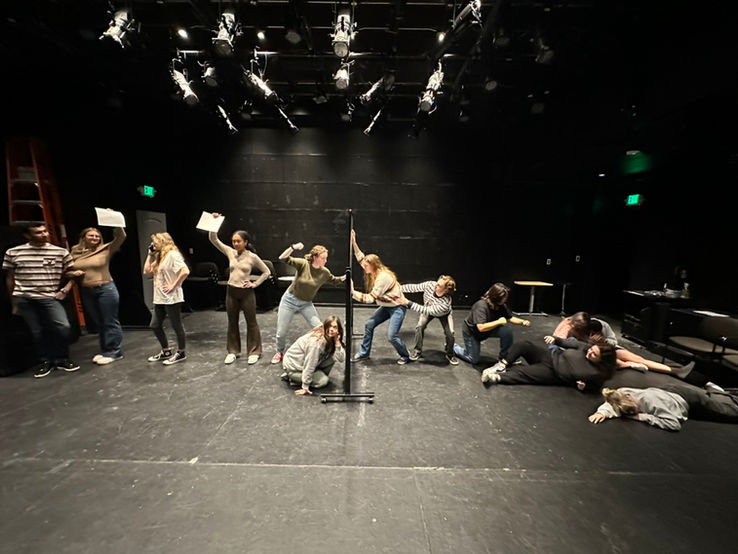
PEDAGOGY
My teaching philosophy is rooted in experiential learning—where ideas aren’t just discussed but lived and practiced. I believe students gain true confidence and understanding when they put theory into action. In class, concepts come alive only when they are embodied and applied.
I focus on giving students a strong foundation in core techniques—such as Stanislavsky’s Magic If, Hagen’s Particularization Exercises, Chekhov’s Four Brothers tenets, and Meisner’s practice of calling out behavior and responding with a clear point of view—while also emphasizing a sense of play through Spolin’s Improvisation Games. Combined with a robust text-analysis vocabulary, these practices equip students to make simple, impulsive, and richly layered choices. Active listening, honest communication, and thoughtful responses shape how we build relationships, collaborate, and move through the world.
In my classroom, I strive to create a space of exploration, collaboration, and fearless creativity. Theatre, to me, is more than performance—it is a practice that sharpens awareness, nurtures empathy, and encourages authenticity. My goal is to guide students not only on stage but also in life, leading them toward a deeper connection with their craft, their community, and themselves.

SHAKESPEARE 1 & 2
When I teach Shakespeare, I focus on making the language alive, clear, and connected to the actor’s imagination. We begin by discovering Shakespearean clues—the rhythms, figures of speech, and word choices that act as a roadmap for performance. From there, we practice following thoughts and arguments, training students to ride the energy of each line and uncover the momentum within the text. I also introduce Chains of Being, an exercise that explores relationships, status, and the invisible forces driving character behavior. Together, these tools help students approach Shakespeare with confidence, curiosity, and play.
DIRECTING ONE
In Directing One, students build a strong foundation for their craft by creating a Director’s Book, a practical guide for shaping their vision of a play. We then move into staging with action, learning how to place and motivate actors in ways that clarify storytelling and deepen dramatic impact. A central part of the course is table work, where we uncover the layers of the script and bring the play’s world to life through questions and discoveries. These tools give students both structure and freedom as they explore the directing process. My goal is to help emerging directors develop clarity, confidence, and creativity in their work.


DIRECTING TWO
In Directing Two, students dive deeper into storytelling by exploring the Hero’s Journey as a framework for dramatic structure. We tackle real-world directing problems, developing strategies to overcome creative and practical challenges in rehearsal. The course culminates in the direction of a one-act play, giving students the opportunity to put their skills into practice and share their vision on stage.
ONE ACT PRODUCTION
In One Act Production, we select 3–4 student directors and guide them through the process of bringing a one-act play to the stage. Each director receives a budget and guaranteed performances, giving them real-world experience in producing a full show. Along the way, students learn how to run production meetings, communicate effectively with their teams, and make collaborative decisions. We also focus on balancing budgets and responsibilities, ensuring that creative choices align with practical realities. By the end of the course, students emerge with hands-on producing and directing experience that prepares them for the professional world.


SCENE STUDY
In Scene Study, students build Character Blueprints to understand motivation, psychology, and inner life. We explore the world of the play, learning how environment, time, and circumstance shape performance. A key focus is on relationships, diving into dynamics that drive conflict and connection on stage. We also double down on objectives, sharpening the actor’s ability to pursue needs with clarity and urgency. To stretch range and perspective, we work with classic Chekhov scenes and end with contemporary film scripts, creating a rich contrast in style and technique.
TEXT ANALYSIS
In Text Analysis, students learn to distinguish between denotative and connotative meanings, rephrasing text to unlock clarity, depth and subtext. We examine the character’s given circumstances, building a strong spine that supports truthful choices in performance. From there, students define objectives at the scene, play, and life level, sharpening their understanding of dramatic action. The course emphasizes close reading and interpretation as tools for both actors and directors. We work with monologues from Tennessee Williams, whose writing offers rich literary devices and layered emotional landscapes for practice and discovery.


INTRO TO ACTING
In Intro to Acting, we begin with theatre games that spark play, reveal behavior, and introduce the building blocks of character. Students practice Uta Hagen’s Physical Destination exercise to develop stage presence and a sense of truth in performance. We then build strong, specific choices through monologue work, while also collaborating on fun and dynamic scenes. Throughout the course, we focus on relaxation and grounding, using breath to connect body, voice, and imagination. By the end, students gain confidence, creativity, and a toolkit for approaching acting with openness and curiosity.











